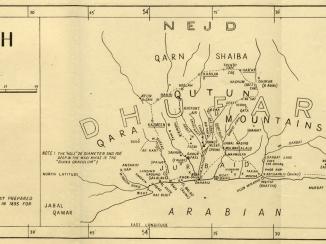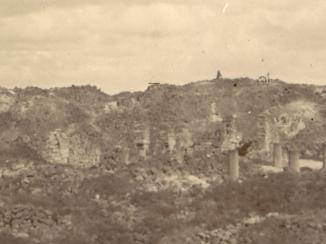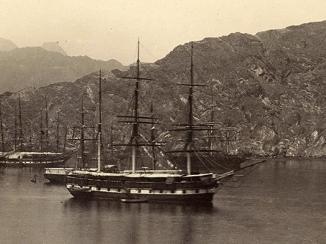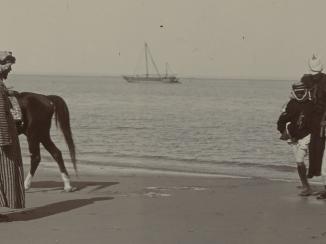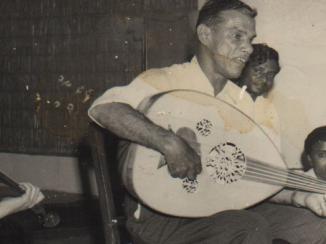'File 5/191 Kidnapping of Baluchis and Indians on the Mekran Coast and exporting them for sale at Oman and Trucial Coast'
IOR/R/15/1/221
511 items in this record
Search within this record
The record is made up of 1 volume (249 folios). It was created in 3 Jan 1921-29 Jul 1922. It was written in English and Arabic. The original is part of the British Library: India Office The department of the British Government to which the Government of India reported between 1858 and 1947. The successor to the Court of Directors. Records and Private Papers Documents collected in a private capacity. .
About this record
- Content
The volume contains correspondence between various British Government officials in the Persian Gulf The historical term used to describe the body of water between the Arabian Peninsula and Iran. , who were responding to a perceived increase in the trade of slaves across the Gulf of Oman, from the Baluchistan coast to the Batinah and Trucial coasts on the Arabian Peninsula. A significant proportion of the volume is intelligence on maritime slave trading activities on the Baluchistan coast. This intelligence was collected by local Baluchis reporting to the Assistant Superintendent of the telegraph office at Jask (Mr Navarra), who telegraphed reports of the activity of dhows suspected of carrying slaves to the Arab coast to the Political Residency An office of the East India Company and, later, of the British Raj, established in the provinces and regions considered part of, or under the influence of, British India. , then under the charge of Major Arthur Trevor. In the case of those boats suspected to be headed to the Trucial Coast A name used by Britain from the nineteenth century to 1971 to refer to the present-day United Arab Emirates. , the Political Resident A senior ranking political representative (equivalent to a Consul General) from the diplomatic corps of the Government of India or one of its subordinate provincial governments, in charge of a Political Residency. requested the Residency An office of the East India Company and, later, of the British Raj, established in the provinces and regions considered part of, or under the influence of, British India. Agent at Sharjah [‘Īsá bin ‘Abd al-Latif] to use the intelligence to retrieve the slaves once they have arrived on the Trucial Coast A name used by Britain from the nineteenth century to 1971 to refer to the present-day United Arab Emirates. . When there was evidence of either direct or indirect involvement on the part of one of the Trucial Coast A name used by Britain from the nineteenth century to 1971 to refer to the present-day United Arab Emirates. shaikhs in slave trading, the Political Resident A senior ranking political representative (equivalent to a Consul General) from the diplomatic corps of the Government of India or one of its subordinate provincial governments, in charge of a Political Residency. wrote directly to the shaikh concerned, warning him of the consequences of his actions (for example, folio 86). Conversely, when a shaikh had taken action in the rescue of a slave, he received praise from the Political Resident A senior ranking political representative (equivalent to a Consul General) from the diplomatic corps of the Government of India or one of its subordinate provincial governments, in charge of a Political Residency. (folio 137).
A report from Captain Brandon, Commanding Officer of HMS Cyclamen , which was patrolling the Baluchistan coast in order to deter slave traders, wrote that a well-known slave trader on the Makran coast was in receipt of a small annual subsidy from the British Government to protect the telegraph line in the area (folios 176-77). This suggestion was contested by Mr Navarra (folios 206-08), though he conceded that others involved in the slave trade on the Makran coast, who have seen their slaves intercepted by British authorities, had threatened to cut British telegraph cables in retaliation. Mr Navarra also suggested that the trade in slaves from Baluchistan to the Arabian Coast, besides being a result of the continued drought and famine in the Baluchistan region, had been recently encouraged by an increase in the trade of rifles from Arabia to Baluchistan, one being used to pay for the other.
- Extent and format
- 1 volume (249 folios)
- Arrangement
The correspondence contained in the volume is arranged in rough chronological order, from the earliest pieces at the front of the volume, to the latest at the rear. Because of the prioritisation of chronological order, sets of correspondence related to specific issues are scattered across the volume, as opposed to be being grouped together, e.g. the reply to a letter on folio 127 may be found much later in the volume, on folio 172.
- Physical characteristics
Foliation: The volume is foliated from the front cover to the inside back cover with circled numbers in the top-right corner of each recto The front of a sheet of paper or leaf, often abbreviated to 'r'. . There is an earlier foliation system using uncircled numbers that runs through the volume. The earlier foliation system is referenced by annotations in the correspondence that refer to earlier correspondence existing in the volume.
- Written in
- English and Arabic in Latin and Arabic script
- Type
- Archival file
Archive information for this record
- Original held at
- British Library: India Office The department of the British Government to which the Government of India reported between 1858 and 1947. The successor to the Court of Directors. Records and Private Papers Documents collected in a private capacity.
- Access conditions
Unrestricted
- Archive reference
- IOR/R/15/1/221
- Former external reference(s)
- A series: 5/191
- Date(s)
- 3 Jan 1921-29 Jul 1922 (CE, Gregorian)
- Context of creation
The British Government had long-standing treaties with the shaikhs of the Trucial Coast A name used by Britain from the nineteenth century to 1971 to refer to the present-day United Arab Emirates. and Muscat dating back to the nineteenth century, promoting the suppression of the maritime slave trade. Though these treaties had originally been set up to prevent the trade of slaves from Africa, the British Government deemed these treaties equally valid to the increase in the slave trade from the early 1920s from Baluchistan – specifically from both the British and Persian Makran coasts. The reasons for the increase in the trade in slaves from Baluchistan to the Arabian Coast was the subject of much debate, but it is likely that the continuing drought and famine in Baluchistan at the time, and the widespread availability of arms on the Arabian coast, had an impact on slave numbers.
Access & Reference
History of this record
Related search terms
Use and share this record
- Share this record
- Cite this record in your research
'File 5/191 Kidnapping of Baluchis and Indians on the Mekran Coast and exporting them for sale at Oman and Trucial Coast', British Library: India Office Records and Private Papers, IOR/R/15/1/221, in Qatar Digital Library <https://www.qdl.qa/archive/81055/vdc_100000000193.0x0000c2> [accessed 25 April 2024]
- Link to this record
https://www.qdl.qa/en/archive/81055/vdc_100000000193.0x0000c2
- IIIF details
This record has a IIIF manifest available as follows. If you have a compatible viewer you can drag the icon to load it.https://www.qdl.qa/en/iiif/81055/vdc_100000000193.0x0000c2/manifestOpen in Universal viewerOpen in Mirador viewerMore options for embedding images
Copyright: How to use this content
- Reference
- IOR/R/15/1/221
- Title
- 'File 5/191 Kidnapping of Baluchis and Indians on the Mekran Coast and exporting them for sale at Oman and Trucial Coast'
- Pages
- 102r:102v, 107r:107v
- Author
- Āl Maktūm, Shaikh Saʻīd bin Maktūm bin Hasher
- Usage terms
- Public Domain
- Reference
- IOR/R/15/1/221
- Title
- 'File 5/191 Kidnapping of Baluchis and Indians on the Mekran Coast and exporting them for sale at Oman and Trucial Coast'
- Pages
- 143r:145v, 183r:184v, 188r:188v, 191r:191v
- Author
- Āl Nahyān, Shaikh Hamdan bin Zayed bin Khalifa
- Usage terms
- Public Domain
- Reference
- IOR/R/15/1/221
- Title
- 'File 5/191 Kidnapping of Baluchis and Indians on the Mekran Coast and exporting them for sale at Oman and Trucial Coast'
- Pages
- 166r:167v
- Author
- Mesopotamia Persia Corporation Limited
- Copyright
- ©P&O Heritage
- Usage terms
- Creative Commons Non-Commercial Licence
- Reference
- IOR/R/15/1/221
- Title
- 'File 5/191 Kidnapping of Baluchis and Indians on the Mekran Coast and exporting them for sale at Oman and Trucial Coast'
- Pages
- front, back, spine, edge, head, tail, front-i, 2r:72v, 73ar:73av, 73v:101v, 103r:106v, 108r:142v, 146r:165v, 168r:182v, 185r:187v, 189r:190v, 192r:252v, back-i
- Author
- East India Company, the Board of Control, the India Office, or other British Government Department
- Usage terms
- Open Government Licence































































































































































































































































































































































































































































































































